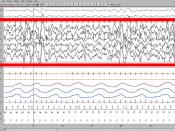Sleep and Sleeping Disorders
Sleep, normal, regular state of rest of an organism. In contrast to the waking stated, sleep is characterized by relative Quiescence of physiological functions(blood pressure, breathing, heartbeat). And a relatively low response to external stimuli.
What? And I thought sleep was something that you had to do when you were just to beat to party on. Well, in this report I will show that sleep is a very important part of our lives that those of us that don't have a problem with it take for granted.
Stages of Sleep
The brain waves of a person go through certain constant changes, classified as stages 1-4, in the course of the sleep cycle. The EEG of a person in the waking state is characterized by alpha waves(8-12 cycles/sec.) And low-voltage activity if mixed frequency.
Stage on only last a few seconds with very low voltage(activity). Then it gives way to stage two with a pattern showing frequent spindle-shaped tracing on the EEG, called sleep spindles, a 13 - 15 cyclessec, and certain high-voltage spikes known as K-complexes.
Soon to follow is the third stage of sleep that begins the appearance of delta waves. Eventually, in stage four these delta waves occupy the major art of the record.
Dreaming Sleep
If the EEG mumbo jumbo loses you then here the dreaming states will clear things up for you.
The stages that I wrote about are really how deep of sleep your brain is in. When you first lay down to sleep, you can notice that you begin to drift off. And little by little you are unaware of your surroundings. The depth of sleep varies during your sleep. The periods are referred to a D-(desynchronized or dreaming )sleep: the remainder of sleep is called S(synchronized) sleep. These two...


